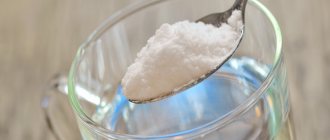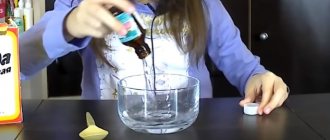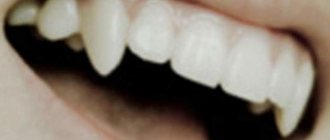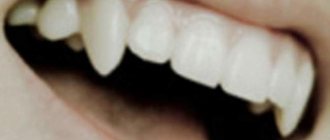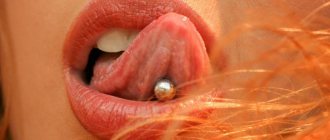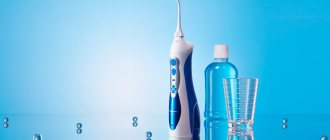Mouthwash: what is it and why is it needed?
Mouthwash is a solution that is part of comprehensive hygiene measures for teeth and gums. Its use enhances the effect of toothpaste and provides better protection against external factors throughout the day. It is found on sale in ready-to-use form, in powder form, which requires subsequent self-dilution, and also in a concentrated state.
Mouthwash is part of comprehensive oral hygiene
Unfortunately, the bristles of a toothbrush cannot always penetrate hard-to-reach places. Interdental spaces, mucosal folds (especially remote ones) and other areas often remain untouched during routine hygienic cleaning. As a result, pathogenic microorganisms accumulate in them, which over time cause inflammatory processes, the appearance of an unpleasant odor, destruction of enamel and other pathologies. The rinsing solution eliminates areas of bacterial accumulation and improves the quality of the hygiene procedure.
Which nozzle is better to use?
In the process of solving the problem of how to use an oral irrigator, the question of correct use of attachments necessarily arises. A set of them can include up to seven pieces, and each of them performs its own specific task. It is these valuable devices that allow you to achieve the desired results.
The main functions of the nozzles are the following:
- Standard . Included with any device. It has no bristles, and its appearance resembles an ordinary tube, bent at a certain angle. It is used to remove plaque and clean spaces between teeth.
- Orthodontic . This attachment is used to clean braces and other similar structures. It looks like a tube with bristles at the end. Due to this, simultaneous water and mechanical cleaning occurs. Very effective in hard to reach places.
- Periodontal . A soft rubber or silicone tip is installed at its end. It has proven itself in cleaning sensitive gums and periodontal pockets. The procedure is performed in a gentle manner, without injury or irritation to the gums.
- Attachment for implants and crowns . Equipped with soft bristles that improve cleaning of bridges, crowns, etc.
- For language . Many people don’t even know how to properly clean their tongue. The nozzle has the shape of a spoon and, without special knowledge, removes plaque from the tongue, soft palate and cheeks.
- Brush attachment . This attachment combines the best features of an irrigator and a regular toothbrush. Water and mechanical cleaning of implants, crowns and the entire oral cavity is carried out.
- Nasal . Designed for washing the nasal cavity in the treatment and prevention of rhinitis. The nozzle is equipped with two tips. From one, a liquid is supplied that rinses the nasal cavity, and from the other, a sprayed drug is supplied that reduces inflammation in the nasopharynx.
Who needs an irrigator and who doesn't?
Of course, the presence of such a device would be desirable in absolutely every home, such as, for example, a good electric inhaler. After all, if a person constantly goes to the dentist with problem teeth, the doctor may suspect that they are genetically bad and advise purchasing a device for cleaning the oral cavity, which he uses in his own office.
If purchasing it for a person is one of the mandatory points in treatment, then, most likely, you will also need to buy a special cleansing solution, because ordinary water does not have medicinal properties.
Vital
And yet there is a category of people for whom an irrigator is a real salvation. These people include patients with diabetes. The nature of their illness is such that any wounds, especially those that bleed, heal very poorly and tend to fester.
These also include wounds that form on the oral mucosa due to many reasons, the simplest of which are stomatitis, a burn, or just a minor injury on the edges of freshly baked bread, for example. The irrigator will prevent their occurrence.
People with orthodontic structures in the form of braces, implants (crowns, dentures). In this case, no toothbrush can replace an irrigator - only this device can fully clean a variety of dental structures from microorganisms that settle on them. It is because of them that teeth under crowns and in place of metal braces so often deteriorate.
Those with braces are strongly advised to use an irrigator.
There are even irrigators specially designed for orthodontic structures. An irrigator is necessary for those who suffer from bad breath. This smell usually comes from food debris that is difficult to remove with a brush from hard-to-reach places. Also, people with so-called crowded teeth cannot do without it - a feature of the structure of the jaw or bite in which the teeth are tightly pressed to each other, which complicates their cleaning.
Can not use
In exceptional cases, it is not advisable to use an irrigator to clean the oral cavity, as this may aggravate the situation. These include:
- recent surgery, after which sutures or wounds have not yet healed;
- undergoing professional dental treatment;
- increased bleeding of gums after a person uses an irrigator for some time;
- when chronic dental diseases worsen, for example, gingivitis or stomatitis;
- inability to use the device, for example, by small children who may simply swallow liquid from the nozzle.
Even after reading all of the above, you may wonder why you need an irrigator and whether this device is such a necessary thing in everyday life. Of course not. But if you want to shine with a natural smile for a long time, it’s time to think about purchasing it.
Device Application
A brush is an indispensable tool for care, but the dentition is heterogeneous; there are crevices and places in it that are difficult to clean completely. If hygiene is poor, these areas will harbor harmful bacteria that feed on carbohydrates derived from leftover food, forming a biofilm, and accumulating plaque that can lead to stone formation. The device was created in the 1960s and has become a real godsend, especially for people prone to dental diseases: when used correctly, the irrigator removes up to 90% of the organic substances responsible for their occurrence from the enamel surface.
The use of this device is recommended for all people who care about their dental health, but it is most relevant for those who wear removable or fixed orthodontic appliances. Braces, bridges, plates, retainers, veneers cannot be properly cleaned with a brush alone, but a directed jet of liquid under pressure copes with this task perfectly and reaches even hard-to-reach places, washing out harmful organic matter from them and destroying the deposits that form.
Rules and methods for using concentrates in irrigators
In most cases, a specialized liquid for an irrigator is universal; it can be used both in the device and independently, as a rinse aid. Despite this, there are simple rules that should be followed when handling concentrates:
- First of all, before using the balm, you need to read the instructions, learn about side effects, contraindications and methods of use. Most solutions need to be diluted with water in a ratio of 1:10, but there are also those that are diluted 1:5. This rule is important to follow, otherwise you can harm your health
After the solution is prepared, it should be poured into a special reservoir of the device. As noted above, most balms can be used daily, after meals as a rinse; just pour it into the cap, filling it one-third full, add water up to the mark, and rinse your mouth with it for about 2 minutes. It is important to take precautions, no matter how harmless the solution may seem at first glance, it should not be swallowed. It is important to monitor children who, due to their age, cannot assess the consequences of improper use of concentrates.
How to use it correctly
Regardless of the type of liquid, the rules for its use should be strictly followed:
- If you use household products, you should carefully study their operating instructions.
- Do not use the liquid if there are contraindications and there are no indications for use.
- The use of homemade solutions is permissible after complete dissolution of all components in them and filtration of herbal decoctions.
- Most of these liquids are presented in the form of concentrates, requiring their preliminary dilution in a ratio of 1:10.
- To prepare liquids, you must use only purified, distilled or boiled water.
- The water temperature should not be more than 38 degrees.
- The most appropriate time for irrigation is the evening after brushing your teeth.
- The liquid is directed to the gums at an angle of 80 degrees, and the duration of the procedure should not exceed 15 minutes.
- The frequency of use of a particular liquid is determined taking into account its type and purpose.
What kind of liquid can be poured into the irrigator?
ordinary water and special liquids are used as filler for the device .
The latter not only mechanically remove plaque from the enamel, but also have a different therapeutic effect depending on the properties of the liquid.
About water for the device
Water is poured distilled, filtered (a simple “jug” filter with a new cartridge is enough), or at least boiled , and then settled. The temperature should be about +40 °C , comfortable for the oral cavity.
This is interesting: Solcoseryl - instructions for using dental adhesive paste
Important! If you use raw tap water or water with too low a temperature, this will affect the health of your teeth and the condition of the appliance .
Store-bought teeth cleaning products
If an additional goal is disease prevention and dental treatment , it is recommended to purchase professional liquids for irrigators at the pharmacy.
They can be either universal or come complete with a device from the company. Special solutions always contain various microelements, vitamins and plant extracts .
Based on their action, the following types of liquids are distinguished:
- To strengthen enamel with fluoride and calcium.
- From unpleasant odor in the mouth with natural flavors.
- From bleeding gums . This symptom usually occurs in people with tartar or periodontitis.
- For sensitive teeth. The components of such solutions are hypoallergenic .
Liquids can have a wide range of applications. They have an antiseptic effect , increase local immunity in the oral cavity and prevent the formation of tartar.
Such store-bought solutions are used as preventive measures. They often contain chlorhexidine .
There are also dental solutions that are used only by professionals, i.e. doctors, in clinics. They are intended for treatment in the postoperative period and are used together with other physiotherapeutic procedures prescribed by the doctor.
Such liquids contain various antiseptic components, for example, miramistin, and biologically active substances . Such solutions are always concentrated. For therapeutic irrigation, they are diluted with saline solution. In each case, the dentist prescribes a specific drug taking into account the patient’s clinical picture.
Action
Choose your irrigator fluid based on your doctor's recommendations.
Irrigator fluids have the following effects:
- Disinfectant. These liquids contain antiseptic components that effectively destroy bacteria in the oral cavity and prevent their proliferation.
- Therapeutic. These are special liquids containing calcium or fluoride that promote remineralization of dental bone tissue. The presence of medicinal herbal extracts in the compositions provides a wound-healing effect, relieves inflammatory processes and pain syndrome in periodontal diseases.
- Deodorizing. Such solutions contain mint or menthol components, which provide fresh breath for a long period of time.
- Preventive. The use of special liquids intended for daily use prevents the development of various dental pathologies. At the same time, the bone tissue of the teeth and gums is enriched with useful substances and minerals. Also, such solutions are able to stimulate blood microcirculation in periodontal tissues, which leads to strengthening of teeth and gums.
Reference! In many ways, the effectiveness of using an irrigator depends on the correct choice of liquid. Its choice should be made exclusively by a specialist, taking into account the clinical picture in the oral cavity and the pharmacological action of the drug.
Liquid release forms. Concentrates and balms
They are different and differ in concentration :
- Rinses and balms . This is a ready-made product, which is immediately poured in its pure form into the container of the irrigator. The amount of solution to be poured will depend on the volume of the device and the amount of liquid that a person needs for one use. The bottle volume is usually 200 ml . Examples: Professor Persin, Waterdent, Donfeel.
- Concentrates. They are already pre-diluted with boiled or filtered water in certain proportions specified in the instructions for the product. Usually it's 1:10 . Examples: Irix, Albadent, Asepta.
After each procedure, the irrigator container is cleared of any remaining liquid and rinsed well with clean water.
Important! Liquid for irrigators should not foam, as foam interferes with pressure.
This will help avoid unpleasant odors and extend the life of the device.
How to clean the waterpik after use
Regardless of the frequency of use of the irrigator, it requires maintenance after each procedure. First of all, the remaining liquid is poured out of the tank to avoid the appearance and proliferation of harmful microorganisms. At the end of each use, the device is turned off, the nozzle is removed, and the remaining water or solution is removed from the container.
After this, the device must be rinsed and dried thoroughly. After use, the nozzle is washed with liquid soap, rinsed with running water and wiped dry with a clean napkin. Disinfection and cleaning of the device should not be carried out with boiling water, since its impact can damage and deform the housing.
If there is any remaining liquid, it is removed by putting the nozzle on and pointing it into the sink. The device turns on and operates for 2-3 seconds, during which all the water from the tubes comes out. The irrigator, washed and wiped dry, is left in the air until the next use.
Even the cleanest water contains impurities that gradually settle, clogging parts and mechanisms. If this happens, you need to use special means and treat the inside of the device. It is also recommended to replace nozzles in a timely manner at intervals of 3 to 6 months. Avoid dropping the device and periodically check all electrical connections.
Types of rinsing solutions
Let's look at the classification of the funds presented today.
Type
There are preventive (hygienic) and therapeutic.
Preventive ones freshen breath, eliminate food debris, prevent the occurrence of dental problems and relieve inflammatory symptoms, strengthen gums and enamel, protect them from bacterial attack, but they are not able to cope with existing serious dental diseases.
Important! Under the guise of “preventive”, today you can find products that only perform the function of freshening breath. That's all. They differ little from each other in composition, and bad breath is often simply masked rather than eliminated the cause of its occurrence. They are of poor quality, contain toxic ethanol, can stain enamel, harm gums, and do not protect the oral cavity from bacteria at all. To avoid disappointment, be sure to consult with your dentist before making a choice.
Therapeutic drugs help in the fight against serious pathologies, but they should be used only as prescribed by the attending physician and at a strictly prescribed time (in courses). Remember that uncontrolled use without assessing and taking into account the real situation in the oral cavity is not a joke.
There are many types of rinses
By purpose
All available types from the great variety of rinses can be divided into 6 types, each of which must be selected in accordance with the problems that you have.
Protection against caries
Products from this series reduce the volume of plaque and thereby protect against caries, reduce the level of acidity in the mouth and strengthen the enamel. They contain calcium, potassium, fluorine ions, amino fluoride or sodium fluoride, plant components, xylitol. Among them are: Elmex “Protection against caries”, PresiDENT Classic Plus, Donfeel and 4-action Mouthwash from Biorepair, Listerine EXPERT “Protection against caries”.
Eliminating bleeding
Irrigating fluids used to irrigate the oral cavity may have an anti-inflammatory effect. As a rule, such balms are recommended for use in cases of gum disease, as well as damage to the oral mucosa.
The solutions contain extracts of medicinal plants: sage, oak bark, chamomile, calendula or St. John's wort, which not only eliminate bleeding gums, but also have an antiseptic and deodorizing effect. Triclosan or chlorhexidine are added to special medicinal elixirs - substances that have a powerful antibacterial effect.
Gum protection
They relieve inflammation and saturate the gum tissue with nutrients, allowing the first manifestations of gingivitis to stop. Among the active compounds they contain chlorhexidine, methyl salicylate, triclosan, benzydamine.
This group includes: Parodontax Extra, PresiDENT “Profi”, CURASEPT ADS with chlorhexidine and hyaluronic acid1, Paroguard from Miradent, Twin Lotus, Splat “Active”. You can use Listerine EXPERT “Gum Protection”, because, as the manufacturer assures, it reduces the inflammatory process by 94%2 and reduces plaque formation by 70%.
The photo shows rinses to protect gums
On a note! Products containing triclosan and chlorheskidine should not be used for more than three weeks in a row, because They, along with a positive effect, can disrupt the composition of the microflora of the oral cavity, cause dry mucous membranes, make the enamel dark and even contribute to the appearance of bad breath.
Enamel whitening
Helps dissolve plaque and reduce the number of bacteria in the oral cavity. Contains active oxygen and hydroxyapatite. For example, GLOBAL WHITE and Blanx White Shock, INNOVA, Listerine EXPERT “Expert Whitening”.
However, you should not expect that they will whiten your teeth by more than 0.5-1 tone; for more dramatic changes, contact a professional dentist.
Daily care and prevention
Permanent comprehensive protection of teeth and gums. Such products can be used every day on an ongoing basis. For example, the “Forest Balm” series, Colgate Plax “Refreshing Mint” (“Colgate”), Listerine “Strong Teeth, Healthy Gums”, “Green Tea”, “Fresh Mint” or TOTAL CARE, SPLAT “Healing Herbs”.
This is interesting: Which toothbrush is better to choose, their types, hardness
To protect sensitive enamel
This classification or type of rinse aid usually includes fluoride and potassium, aluminum. The components reduce irritation from external factors and restore the surface of the teeth. An example would be: Elmex Sensitive+, Lacalut Sensitive, ROCS “Active Calcium”, Colgate Plax “Freshness of Tea”.
Basic rules for choosing a liquid
When choosing a solution for an irrigator, you should consider its purpose and composition. Depending on the active components, the solutions used during irrigation are intended for:
It is also worth considering the type of liquid. It is strictly forbidden to use professional compositions at home. People prone to allergies are recommended to give preference to hypoallergenic balms. When preventing dental pathologies, as well as for children, special gentle formulations should be used, preferably without alcohol.
If there is a problem with the constant occurrence of inflammation of the mucous membranes of the oral cavity, preference should be given to liquids that have an anti-periodontal effect. They contain compositions of various bioantioxidants and anti-caries additives.
A preliminary consultation with a dentist will help you make the right choice. Using unsuitable solutions can lead to side effects such as thinning or darkening of tooth enamel.
Rules for caring for the device
The irrigator, like all electrical appliances, requires special care. The device should be washed as follows: firstly, do not under any circumstances immerse the entire irrigator in water, especially when it is turned on - it may short out (which is deadly!), and its parts may rust. Secondly, do not use unboiled water to clean the device, only filtered and, preferably, warm water. Otherwise, scale will form inside the mechanism, which will lead to its breakdown. In order to thoroughly clean the irrigator, you need to fill it exactly halfway with warm water, empty the reservoir after a couple of minutes, rinse the device and nozzles for the irrigator, and then wipe all components dry. Particularly advanced manufacturers produce devices together with a UV sanitizer designed to disinfect replaceable attachments. The ultraviolet radiation on which it works destroys microbes accumulated on the tips and thus prevents the development of dental diseases. As for the storage conditions of the irrigator, it should be kept in a dry place. Touching the appliance plug with wet hands is strictly prohibited.
In principle, the irrigator should not be cleaned too often, except for those cases when you pour special decoctions into its tank. Particles of herbs from the infusion remain inside the device and may damage its operation.
Multifunctional irrigator OR 820M Donfeel with nasal attachment
The best anti-caries mouth rinses
President Classic Plus
The rinse contains sodium fluoride (250 ppm), xylitol and plant components (extracts of lemon balm, sage and chamomile). Protects tooth enamel from damage by caries and has a pronounced refreshing effect. It does not contain antiseptics or alcohol, so it is approved for use in children over 6 years of age and people whose profession involves driving vehicles.
Main advantages:
- pleasant aroma,
- soft taste,
- long lasting breath freshening.
The best rinses for complex therapy of periodontal diseases
Lacalut active
Lacalut active mouth rinse is produced in Germany. It contains sodium fluoride (225 ppm), 0.25% chlorhexidine digluconate, aluminum lactate and does not include ethyl alcohol. An antiseptic (chlorhexidine) fights the development of the infectious process, aluminum lactate has an astringent effect, which eliminates bleeding gums, and sodium fluoride protects teeth from caries. Lakalut asset cannot be used for more than 21 days. Main advantages:
- effective,
- has a good smell and taste.
Minuses:
- To achieve the expected result, you need to take several courses.
Asepta
A Russian rinse that contains two antiseptics (chlorhexidine bigluconate - 0.05%, benzydamine - 0.15%), xylitol. It has a pronounced antibacterial effect and a slight analgesic effect. The drug can be used in the treatment of ulcerative-necrotic and hypertrophic forms of gingivitis (inflammation of the gums). The maximum permissible period of use is 14 days. With prolonged use, it can cause the development of dysbiosis of the oral cavity. Main advantages:
- mint, not very pronounced taste,
- does not contain artificial colors or alcohol,
- pronounced positive effect.
Minuses:
- quickly consumed.
The best plant-based mouth rinses
Forest balm
Mouthwash from the Forest Balm brand is intended for comprehensive maintenance of the oral cavity in a healthy condition. It will not solve serious problems, it is intended mainly for prevention. The product protects against caries and strengthens enamel due to a mineral complex with fluoride. The Russian concern Kalina produces Forest Balsam rinse in 13 versions, not all of them have a purely herbal composition. Some may contain fragrance, an organic solvent, or the antiseptic triclosan. When purchasing, you should pay attention to the components included in the product. Main advantages:
- pronounced effect,
- pleasant taste,
- affordable price.
Minuses:
- the composition is not 100% natural.
MEXIDOL dent Professional
Rinse aid made in Russia. The composition includes: anti-inflammatory component methylhydroxyperidine succinate (or Mexidol), licorice root extract, amino acid complex. Suitable for periodic use, prescribed to prevent the development of inflammatory processes for people prone to developing stomatitis and those who wear removable dentures. Main advantages:
- moisturizes the mucous membrane,
- heals wounds with stomatitis well.
Minuses:
- Recommended only for certain diseases.
Features of cleaning teeth and gums with an irrigator
Before you start using an oral irrigator, you must first use the instruction manual. In addition, you need to take into account the features of this device and pay attention to the advice and recommendations of specialists. This is the only way to ensure safety and maximum effect from its impact.
Taking into account the specifics of the device, a number of conditions must be observed during its operation:
- Under no circumstances should you replace your toothbrush; use an irrigator together with it as an additional procedure for cleaning hard-to-reach and inconvenient places in the oral cavity.
- It is recommended to start using the device with a gentle mode. The unusual effect on teeth and gums will be mild, eliminating possible discomfort. Gradually, the water pressure can be increased and eventually reach the required level.
- If you have crowns, bridges, braces and other structures, cleaning is performed not only after using a toothbrush, but also after each meal.
- Do not floss before using the waterpik. The floss may accidentally damage your gums, and subsequent exposure to the jet may only make the condition worse.
- When applying water, it is recommended to lift the tongue up. In this case, it will be possible to avoid liquid getting into the respiratory tract and stomach. The waste water will simply flow out by gravity.
- If painful sensations occur, cleaning should be stopped or switched to a lower pressure.
- You can buy one device for the whole family, but replaceable attachments are for individual use only. Therefore, they are purchased separately for each person, in accordance with his needs.
- Children can use the waterpik only under parental supervision. Children aged 3 to 6 years are recommended to use special children's models. However, experts insist on using devices only after the age of six. This is due to possible developmental disorders of baby teeth.
- If bleeding gums or inflammation of the mucous membrane occurs in an acute form, observed for three days or more, the procedures should be stopped and their further implementation should be agreed with a doctor.
It must be remembered that the use of the device has serious restrictions, the violation of which is strictly prohibited. These include:
- The device cannot be turned on if the liquid reservoir is empty.
- Do not use too hot or cold water. Any liquid must be at room temperature to avoid injury to tooth enamel and burns to the mucous membrane.
The best mouth rinses for hyperesthesia (increased sensitivity) of teeth
Lacalut sensitive
The German LACALUT sensitive mouth rinse is a prime example of excellent quality at a reasonable price. Reduces the sensitivity of enamel to hot and cold, sweet and sour. Protects sensitive teeth from caries, strengthens gums. In addition to amino fluoride, the drug contains aluminum lactate with a pronounced astringent effect and an antiseptic, which requires use for no more than 21 days. Main advantages:
- Reduces tooth sensitivity well
- refreshes the oral cavity,
- helps cope with bleeding gums.
Minuses:
- The bottle lasts for a short time.
Since many rinses contain antiseptics or alcohol, it is not recommended to choose them yourself. In order for the effect of the rinse to be maximum, you need to contact a dentist to determine the problems of the oral cavity and carry out complete sanitation (treatment of all dental diseases) and professional hygiene.
Varieties
In order to satisfy the needs of device users, irrigators are produced in various configurations, with different specialized attachments. Irrigators are either stationary or portable. The stationary one can be installed in the bathroom, and the portable one can be taken with you on vacation or a business trip. There are models with the ability to adjust the mode and additional options, for example, with the generation of small bubbles for a softer and more effective cleansing. Some models of irrigators can be connected to a water supply, others operate from a built-in reservoir.
The best rinses with teeth whitening effect
Whitening rinses prevent the appearance of enamel stains, plaque and tartar, and also help to gently brighten the surface. However, you shouldn’t expect the effect of professional whitening and a difference of 3-4 tones from them, of course.
Colgate Optic White – popular whitening rinse
Colgate Optic White removes plaque and stains on enamel, thereby restoring the natural whiteness of teeth. The effect is visible within a week after daily rinsing. The mint in the composition not only gives a pleasant taste to the product, but also destroys bacteria, freshening your breath. The feeling of cleanliness remains until the next meal.
The rinse aid is sold in white plastic bottles of 250 or 500 ml. The cap serves as a convenient dispenser. A volume of 500 ml when used twice a day is enough for about a month.
Pros:
- removes plaque and stains on teeth;
- eliminates unpleasant odor;
- does not sting when rinsing;
- low consumption;
- sold in most stores.
Minuses:
- short-lived whitening results;
- not recommended for sensitive teeth.
Colgate Optic White mouthwash is most effective when used with a toothpaste and brush from the same series.
Splat Active White – effective whitening rinse
Splat Active White is recommended for regular use after meals to maintain oral hygiene. It actively fights plaque and stains from dark drinks, and also freshens breath. The proprietary patented Luctatol system prevents the appearance of caries, blocking plaque deposition by 96%. However, the list of active ingredients here is quite extensive.
This is interesting: How to remove tartar using ultrasound: advantages and disadvantages
Tetrasodium glutamate diacetate and the plant enzyme papain ensure the removal of pigmented plaque. Lactic enzymes and zinc ions create an antibacterial barrier, block the development of pathogenic flora and fight unpleasant odors. Licorice extract helps prevent caries. Biosol and thyme essential oil provide anti-inflammatory and antiseptic effects to prevent bleeding gums.
Pros:
- affordable price (about 150 rubles for 275 ml);
- pleasant taste;
- noticeable whitening effect;
- suitable for irrigators;
- prevention of bleeding gums.
Minuses:
- you need to keep it in your mouth for a whole minute;
- may cause allergies.
The rinse is recommended for use with Splat Professional “Whitening Plus” paste for maximum brightening results. The product is compatible with irrigators and is suitable for people with braces and other orthodontic structures.
What is the irrigator created for?
Modern dentistry is aimed not only at high-quality dental treatment, but primarily at disease prevention. For this purpose, a hygiene device was developed, namely, removing food debris, washing away bacteria, cleaning hard-to-reach places, neutralizing an acidic environment, and preventing tartar. It's called an irrigator. The device looks like a reservoir into which a special liquid is poured, and then the oral cavity is irrigated under pressure with a thin stream from the nozzle.
Advantages of using an irrigator:
- available for purchase: can be found at an electronics store at a reasonable price;
- easy to operate;
- easy to clean;
- instead of special solutions, you can pour ordinary water into the tank;
- promotes effective cleansing of hard-to-reach places;
- Cleaning time is fast;
- does not cause pain or discomfort;
- helps wash away pieces of food, improve gum health, improve blood circulation;
- has no harmful effects;
- no side effects;
- recommended when wearing braces or dentures;
- the effect is higher than when using dental floss;
- improves oral health in two weeks.
Best lists
Let's determine the most effective mouth rinses by category:
- budget;
- anti-caries;
- for children.
Budget
Fluorodent is the most budget-friendly mouthwash option on our market. Its price ranges from 40 to 110 rubles. But still, this product has an antibacterial effect, strengthens enamel, whitens, and freshens breath. The structure of the rinse is based on a mixture of essential oils: lemon, mint, anise, clary sage.
mouth rinse Fluorodent.
Anticarious
Elmex “Protection against caries” copes well with its main task, but also has an antibacterial effect and strengthens the enamel. The cost of the product is generally 600 rubles.
Elmex mouth rinse Protection against caries.
For children
Drakosha is an excellent representative of a baby mouthwash. You can purchase it for up to 100 rubles. It is absolutely safe for your children, but it is better to make sure that the child does not swallow this liquid.
Drakosha mouth rinse.
What to do if you run out of liquid?
You can prepare the liquid for the irrigator yourself. For example, at home you can use the following recipes:
- Baking soda solution: 2 dessert spoons per 300 ml of water. The solution has a strong antimicrobial effect and provides complete care for enamel and gums.
- Table salt solution: a teaspoon per 200-250 ml of boiled water. Effectively destroys pathogenic bacteria, but is not suitable for frequent use: it weakens tooth enamel.
- Hydrogen peroxide solution: 3 full caps of 3% composition are dissolved in a glass of water. This is an excellent antiseptic for caries prevention.
You can also make a solution from decoctions of medicinal herbs and plants: fireweed, sea buckthorn, chamomile, etc.
In any case, the liquid prepared by yourself must be of a uniform consistency and not contain undissolved particles that could damage the device. Therefore, it is better to purchase liquids for irrigators in ready-made form.
Which liquid to choose directly depends on the dental problem that needs to be solved. There are no universal drugs that can get rid of all diseases. We recommend not to self-medicate, but to consult a dentist. The doctor will identify the problem and select the best liquid for the irrigator that can solve the problem without risk to health.
Recipes for making your own liquids for irrigators
Many experts recommend using homemade solutions from gentle ingredients that are easy to make with your own hands:
- Soda solution. 10 g of baking soda should be thoroughly dissolved in 0.3 liters of warm boiled water.
- Salt liquid. Mix 300 ml of warm purified water with 5 g of unflavored sea salt. Stir until it is completely dissolved.
- Hydrogen peroxide based solution. Mix 250 ml of water at room temperature with 10 ml of the main raw material.
Important! Despite the ease of preparation of these solutions, their use and duration of use should be agreed with a doctor. Incorrect concentration and prolonged use can lead to dehydration of teeth, increased sensitivity, as well as destruction of connective tissue and loss of dental strength.
Is it allowed to leave liquid in the container after the procedure?
If the solution in the reservoir is not completely used up, it is usually tempting to leave it for next time so as not to waste time pouring a new one. You shouldn't do this. The fact is that it forms an excellent breeding ground for bacteria, including pathogenic ones, which, under suitable conditions, will begin to multiply rapidly, making subsequent manipulations with the use of waste filler harmful to the body.
After use, the tube must be rid of any remaining water by allowing it to run empty for a few seconds after drying. This is especially important for portable devices in cold weather conditions (for example, while traveling): when freezing, the liquid expands and can damage the fragile tube.
Using the irrigator correctly - step-by-step instructions
- Fill the reservoir with water or a special liquid at a comfortable temperature.
- Select the desired nozzle and install it on the handle of the device.
- Adjust the jet pressure.
- Place the nozzle in your mouth and press it lightly with your lips, then turn on the device.
- Lean over the sink and open your mouth slightly to allow the water to flow into the sink after cleaning.
- Direct the jet towards the teeth at a 90 degree angle. Dentists recommend this cleaning scheme: divide the entire jaw into four parts and treat them one by one. For example, first the upper left part is processed, then the upper right, then you can move on to the lower jaw using the same principle.
- When moving from one tooth to another, you need to stop at the interdental spaces, because Small pieces of food often remain between them and bacterial plaque accumulates.
- After treating the entire oral cavity, remove the nozzle and install it on a special mount.
- Drain the water tank.
Remember! When cleaning your gums, you need to hold the nozzle so that the stream is directed from top to bottom. This precaution will prevent the gum tissue from moving away from the tooth.
Tips for making your mouthwash as effective as possible
To achieve a pronounced effect from using a rinse solution, you will need to follow some recommendations:
- The optimal moment for rinsing is considered to be the time after brushing the teeth, when their surface is most “open” for the absorption of active substances,
- You should not put more than 20 ml of product into your mouth, and do not take the rinse aid several times. This will not affect the final result, but more solution will be needed. In addition, the likelihood of components entering the gastrointestinal tract increases, which can lead to stomach and intestinal upset,
- There is no need to dilute the ready-to-use solution with water,
- Some solutions require a longer rinse. This mainly applies to liquids intended for the treatment of dental problems, for example, those containing fluoride and sodium compounds,
- The rinse is not intended for oral use; if you accidentally swallow a small amount, of course, nothing will happen. But we strongly recommend drinking a fairly large amount of plain water, thus flushing your stomach,
- You should not use formulations with alcohol for longer than two weeks in a row - this can cause dehydration of the mucous membrane.
And remember that the mouthwash is by no means a complete replacement for other oral care products: brushes, pastes, irrigators. All of them must be used comprehensively.
Sources:
- https://anZub.ru/esteticheskaya-stomatologiya/opolaskivateli-dlya-rta/
- https://vibiraite.ru/zidkost-dla-irrigatora.html
- https://stomatr.ru/o-zubah/uhod-za-polostyu/rastvor-dlya-irrigatora-polosti-rta-svoimi-rukami.html
- https://stomatologliliya.ru/sredstva/zhidkost-dlya-irrigatora-kak-vybrat-rastvor-ili-prigotovit-ego-svoimi-rukami
- https://teeth-health.ru/rastvor-dlya-irrigatora-polosti-rta-svoimi-rukami/4177.html
- https://denta-log.ru/rastvor-dlya-irrigatora-polosti-rta-svoimi-rukami.html
- https://www.expertcen.ru/article/ratings/luchshie-opolaskivateli-dly-polosti-rta.html
- https://vyboroved.ru/reyting/luchshie-opolaskivateli-dlya-rta
- https://oxko.ru/luchshie-opolaskivateli-dlya-polosti-rta/
- https://waterpikrussia.ru/article/kakaya-zhidkost-dlya-irrigatora-luchshe
- https://dentoland.com/gigiena/chistka/zhidkost-dlya-irrigatora.html
- https://PlastikaPlus.ru/uhod-za-zubami/kak-pravilno-polzovatsya-irrigatorom.html
How to choose the cleaning mode and water pressure
When cleaning your mouth with an irrigator, you should not forget about the correct operating mode. First of all, this is the pressure of the water jet, which is adjusted with a special button or control knob. Even the simplest and cheapest models can work in two versions - strong and weak.
During the initial period of use, the gums may not react correctly to external influences. Therefore, at this stage, the minimum gentle regimen should be used. Gradually, the mucous membrane and the entire cavity will get used to this pressure, and after 1-2 weeks it will completely adapt to it. If there is no discomfort, you can gradually increase the power of the supplied jet.
Strong pressure does not always provide the desired result. If you have hypersensitivity or diseases of the mucous membrane, you should not use the maximum mode to avoid serious injury to the gums. If it is not possible to consult a dentist on this matter, it is recommended to rely on your own feelings.

